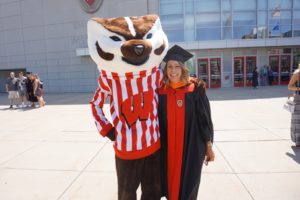We sit in Colectivo during the peak afternoon hour. Over blaring indie rock music and the chatter of other coffee house inhabitants, Katherine Leifer, August 2017 graduate of UW-Madison’s Sustainable Systems Engineering master’s degree program, tells me, a UW-Madison marketing intern, about her plan to save the environment.

Leifer is enthusiastic and animated as she explains scientific sustainability topics that are beyond me – especially about the value of waste heat. Before this moment, I’d never heard “waste” and “heat” in the same sentence, yet it’s the most used phrase in our conversation.
What did I get myself into?
I type what she says and nod with hesitation, adding multiple question marks in my notes to Google later. As a communications major, science doesn’t come easy to me. (But you got to fake it till you make it, right?)
Unlike me, Leifer’s expertise lies in sustainability. Also unlike me, Leifer is not the type to fake it. Or if she does, she sure “makes” it well: While thriving in her master’s program, she worked full-time as a senior account manager for Alliant Energy in Fond du Lac, Wis. The program took up a lot of her time in addition to working, but Leifer enjoyed being engaged back in school, and she’s already feeling the benefits.
“[Even though] I just graduated in August, I think my value to the company, I’m hoping, has grown as a result of the degree,” Leifer says, which is always promising for a student like me to hear.
“I’m a definite believer in life-long learning… I just wanted to do something that honestly would challenge me mentally,” she says. I tell her a master’s degree sounds like a good enough challenge, which happened to be at the same place she got her undergrad degree 15 years ago. (Once a Badger, always a Badger, am I right?) It was through this “challenge” that she planned a capstone project to improve the environment by reducing carbon emissions.
When machines operate, they produce energy that must be released, most often in the form of heat. The released heat is known as waste heat. So why is it a big deal? Waste heat is valuable because it’s energy. Most importantly, it’s a free source of energy. This free energy can be recycled to be reused as heat or energy for other sources.
Many institutions use waste heat to their financial and environmental benefit. Foundries use waste heat from furnaces to preheat metals to avoid dumping cold metal straight into the furnace. Computer data centers use waste heat for space heating other parts of their buildings. Some European countries use it to heat neighborhoods with underground piping.
Leifer focused on using waste heat to heat greenhouses in the winter. (The heating technique would be particularly useful up nort’ like here in Wisconsin where it’s real cold, ya know?) Otherwise, natural gases are used to heat greenhouses, resulting in significant carbon emissions.
So, if waste heat and greenhouses are such a great match, why isn’t the pair as popular as it theoretically should be? In the U.S., we are stopped by logistics.
“The challenge with waste heat is it can’t really travel far. It’s the coordination of where you’re trying to capture it from, and where you’re trying to put it. Logistically, the [plant and greenhouse] have to be fairly close,” Leifer says.
With big, centralized power plants that tend to be outside of the U.S.’s urban areas, it’s difficult to pair plants and greenhouses (or other establishments benefitting from the waste heat).
On the other side of the ocean, many countries make the most of their waste heat. Denmark gets half its electricity from recycled heat, and Russia uses 31 percent of its own, according to Leifer. What Europe has that the U.S. doesn’t are sustainability incentives and policies.
In the U.S., we waste about half as much energy as we produce, mostly in the form of heat. Just 12 percent of waste heat is recycled for electricity. If we could use waste heat instead of natural gas, we could reduce carbon emissions by 17 percent, she says.
Leifer reads these stats from her 67-page capstone project paper about waste heat as we sit in the coffee shop. She looks proudly at it, then says, “You can just take this,” as she sees me scramble to type what she just read.
Several days later, I sit at my desk studying the paper and my notes with the trailing question marks. After some Googling, I think I am starting to understand the whole waste heat thing. Sort of. Ok, just barely.
And as I do so, I also understand why Leifer is so passionate about moving towards a more renewable energy source like that. Though it’s a small step in the grand scheme of things, it’s still a step closer to more renewable energy sources and a more sustainable world.
But my understanding of everything else about science? That’s another story.